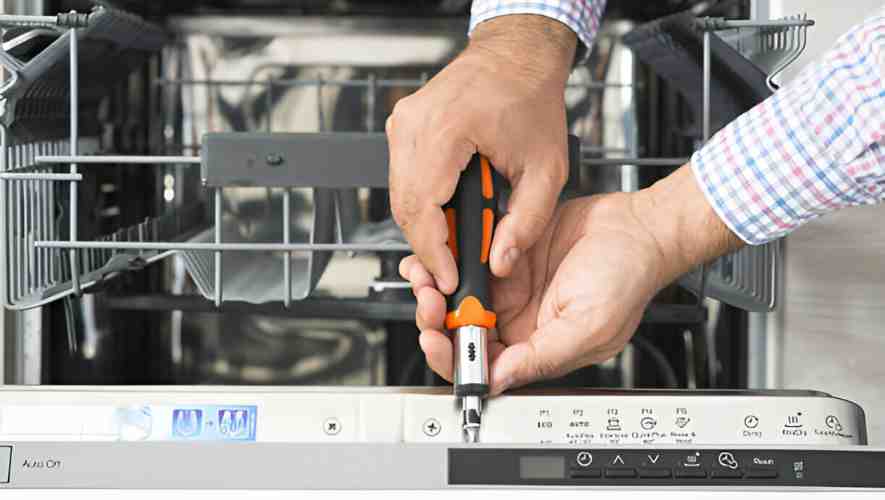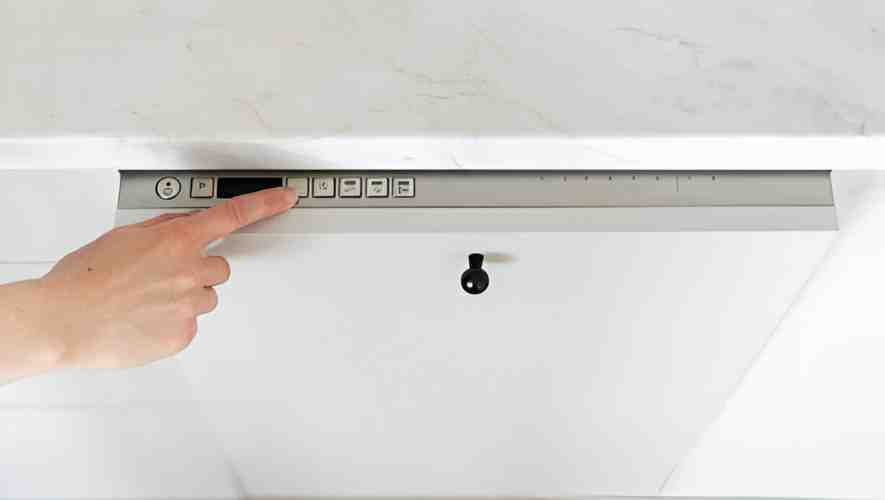
Your LG dishwasher won’t turn on? Don’t worry, we’ve all been there. It can be super frustrating when an appliance suddenly stops working. First things first, let’s troubleshoot this problem together. Start by checking if the dishwasher door is properly closed and latched. Sometimes, a door latch or door switch issue can prevent it from starting.
Why Won’t My Lg Dishwasher Turn on? Having trouble with your LG dishwasher? If it won’t turn on, troubleshoot common issues like door latches, control panels, and fuses to fix the problem quickly.
Next, inspect the control panel and make sure it’s not damaged. If the control board seems fine, it might be worth checking the breaker or circuit breaker to see if it’s been tripped. Also, check the fuse or thermal fuse to make sure they’re not blown. Using a multimeter can help you test these components.
Sometimes, the problem lies within the main control board, which might need a reset or replacement. Always refer to the user manual for specific instructions related to your model. Fixing these things can often get your dishwasher back up and running in no time!
Common Reasons Your LG Dishwasher Won’t Start: Latches, Fuses, and More

Door Latch and Door Switch Issues
One of the most common reasons your LG dishwasher isn’t working is because the door latch or door switch is faulty. If the door is closed but the dishwasher doesn’t start, it might be due to the door latch not engaging properly. Ensure the latch clicks firmly when you close the door. If it doesn’t, you might need to replace the latch or door switch to prevent the dishwasher from starting issues.
Control Panel and Start Button Problems
Your LG dishwasher won’t start even when the door is closed and latched correctly. This can be due to problems with the control panel or the start button. Check if the touchpad and control panel respond when you press the buttons. If not, the control panel might need to be replaced. Also, make sure the child lock isn’t activated, as this can prevent the dishwasher from starting.
Checking the Fuses and Circuit Breaker
Another reason your LG dishwasher isn’t working could be related to the fuses or the circuit breaker. Ensure the dishwasher’s power supply is intact and that it’s in the on position. If the dishwasher’s power isn’t working, check the thermal fuse and the main control board fuse using a multimeter. Replace any blown fuses to get your dishwasher back to running.
Inspecting the Water Inlet Valve and Water Line
Dishwasher doesn’t start a wash cycle, the problem might lie with the water inlet valve or the water line. Make sure the water line is connected properly and the valve is not clogged. The dishwasher’s water supply is crucial for it to function, so ensure the water inlet valve is working correctly to avoid starting issues.
Error Codes and LG Dishwasher Troubleshooting Tips
Error codes can also prevent the dishwasher from starting. Refer to your user manual to understand what each error code means. Common error codes can indicate problems with the water inlet valve, control board, or other lg dishwasher parts. Follow the LG dishwasher troubleshooting tips provided in the manual to resolve these issues and get your appliance working again.
Delay Start and Immediate Start Settings
Sometimes, the delay start feature might be activated, causing the cycle to delay instead of starting immediately. Check if the delay start setting is on. If it is, cancel the delay to allow an immediate start of the wash cycle.
Appliance Repair and Professional Help
If you’ve tried all the above steps and your LG dishwasher still won’t start, it might be time to call in an appliance repair professional. They can diagnose and fix more complex issues that might be preventing your dishwasher from starting, ensuring it gets back to running smoothly.
How to Troubleshoot an LG Dishwasher Not Starting: Control Panels, Door Switches, and Error Codes

Check the Basics First
New dishwasher isn’t starting, start with the basics. Make sure the dishwasher is plugged in and receiving power. Sometimes, it’s connected to a kitchen switch that might be off. Check the circuit breaker box and reset any tripped breakers. Even if it has power, a tripped breaker can prevent it from starting.
Inspect the Door Switch and Latch
One of the most common reasons your LG dishwasher won’t start is due to door issues. The dishwasher won’t start even if the door seems closed. Ensure the door switch and latch are working correctly. When closing the door, listen for a click that indicates the latch is engaged. A faulty latch or door switch can prevent the dishwasher from starting.
Test the Touchpad and Control Panel
The touchpad and control panel are crucial for the dishwasher’s operation. If these components are unresponsive, the dishwasher won’t start. Check if the control panel lights up when you press the power button. If not, you might need a diy repair or professional help to fix an LG dishwasher control panel.
Examine the Dishwasher Control Board
The dishwasher control board controls the functions and cycles of the dishwasher. If your dishwasher isn’t starting, the control board could be faulty. Look at the top of the dishwasher where the control board is located. If it looks damaged or doesn’t respond, it might need replacement to fix the problem.
Decode Error Messages
Error codes can provide clues about why your dishwasher isn’t starting. Common error codes might indicate issues with the water flow or other internal problems. Refer to the user manual to understand these codes. Fixing the issues indicated by these codes can often resolve the problem.
Check the Water Supply
A lack of water flow can also prevent your dishwasher from starting. Make sure the water inlet valve is open to allow water into the dishwasher. If the valve is clogged or the water line is disconnected, the dishwasher won’t start. Ensure everything is connected properly to maintain water flow.
Reset Any Tripped Breakers
Dishwasher won’t start, check the circuit breaker box and reset any tripped breakers. Sometimes, the dishwasher’s power button might be on, but the breaker might have tripped, cutting off power to the appliance.
Additional DIY Repair Tips
For those comfortable with diy repair, checking internal components like the thermal fuse or float switch can help. These parts can sometimes prevent the dishwasher from starting. However, if you’re unsure, it might be best to consult a professional to avoid causing more damage.
Why Won’t My LG Dishwasher Turn On? Check the Control Board, Thermal Fuse, and More

Ensure Power to the Dishwasher
First things first, make sure the power to the dishwasher is on. Check if the dishwasher is properly connected to your home’s power supply. If you’re dealing with power issues, check the circuit breaker to see if it’s tripped. Reset it if necessary, and make sure the outlet supplies power. Sometimes, a firm push on the power plug can resolve loose connection issues.
Check the Control Board
The control board sends power to various parts of the dishwasher and controls its functions. If the control board is not working properly, the dishwasher won’t start. You might need to inspect the board for any visible damage or burnt areas. If damaged, the control board must be replaced.
Test the Thermal Fuse
The thermal fuse is another critical component. If the fuse blows, the dishwasher won’t start. Use a multimeter to test the thermal fuse for continuity. If it’s blown, it will need to be replaced. This part prevents the dishwasher from overheating, so it’s crucial for safety and functionality.
Verify the Water Supply
There may be a water supply issue if the dishwasher isn’t starting. Ensure the water inlet valve is open to allow water to flow into the dishwasher. Check the water line from your home supply to the dishwasher for any kinks or blockages. Proper water flow is essential for the dishwasher to operate.
Look at the Float Switch
The float switch detects the water level inside the dishwasher. If it’s stuck or malfunctioning, it can prevent the dishwasher from starting. Make sure it moves freely and isn’t obstructed by debris. If it’s not working properly, the float switch may need to be replaced.
Examine the Door Switch
The door switch ensures the dishwasher only runs when the door is properly closed. If the door switch is defective, the dishwasher won’t start. Test it with a multimeter to see if it’s functioning correctly. If not, the door switch will need to be replaced.
When to Call for Professional Help
If you’ve checked all the above and your dishwasher still isn’t working, it might be time for a professional dishwasher repair service. Some problems are too complex for DIY fixes and require a professional’s expertise. A professional dishwasher repair technician can diagnose and fix deeper issues, ensuring your dishwasher runs smoothly again.
Conclusion
In conclusion, troubleshooting why your LG dishwasher won’t turn on can be straightforward if you know where to look. Start by ensuring there’s power to the dishwasher and that it’s plugged in. Sometimes, a firm push to engage the power plug or checking the kitchen switch that must be on can resolve power issues. Inspect the door latch and door switch, as these may be damaged and require replacement if they don’t close properly.
The control board is crucial as it sends voltage to the appropriate functions. If it’s faulty, it will need to be replaced. The thermal fuse, which prevents overheating, should be tested for continuity with multimeter testing. If the fuse is blown, replace it.
Also, verify that the water could flow through the line without obstructions, ensuring the water inlet valve is functioning. The float switch and door switch are other components to check if the dishwasher isn’t starting. The float switch ensures proper water levels, while the door switch ensures the door is closed.
Finally, refer to the user manual to determine the meaning of the code if your dishwasher displays an error. Understanding these error codes can help pinpoint the source of the problem. If you find one or more buttons on the control panel unresponsive or if the problem persists despite your efforts, it’s time to call for professional dishwasher repair service. A professional can accurately diagnose and fix the issue, getting your dishwasher back in working order.
